The sport that began on abandoned airstrips and isolated stretches of public highway, practiced by individuals with a penchant for speed, thrills and danger underwent a transformation years ago, gradually attaining respectability and acceptance amongst those who once considered drag racing the province of socially challenged individuals who had little respect for the law or the safety of others. Those once considered undesirables eventually became folk heroes who were applauded for their contributions and innovation in a world that praised them for daring to put their lives on the line while racing at facilities that were considered marginal at best.
The early years were simpler times when just re-jetting a carburetor, and inst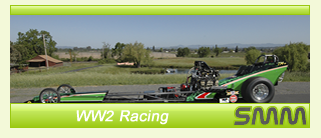 alling a new set of points and a fresh set of Champion plugs might get you into the trophy run at your local drag strip. Flagmen eventually gave way to the Chrondek “Christmas Tree” in late 1963 and with the advent of increasing speeds, racers soon realized the necessity of moving away from the “shade tree” technology that was once sufficient enough to get them to the end of the strip in one piece. Chassis manufacturers like Logghe and Dragmaster insured the measure of safety and confidence needed as fuelers inched closer and closer to quarter mile speeds of 200 mph. alling a new set of points and a fresh set of Champion plugs might get you into the trophy run at your local drag strip. Flagmen eventually gave way to the Chrondek “Christmas Tree” in late 1963 and with the advent of increasing speeds, racers soon realized the necessity of moving away from the “shade tree” technology that was once sufficient enough to get them to the end of the strip in one piece. Chassis manufacturers like Logghe and Dragmaster insured the measure of safety and confidence needed as fuelers inched closer and closer to quarter mile speeds of 200 mph.
The 1950’s, 60’s and 70’s are widely recognized as being the “golden age” of drag racing due to rapid chassis, tire and safety innovations, sanctioning body organization and the primal excitement generated by the gassers, dragsters, altereds, funny cars and factory sponsored super stocks that roamed the asphalt on strips across the country. There was something there for everyone because what you saw on Sunday wasn’t that much different from what you drove on Monday. It was a sport that had relevance to anyone whoever had a desire to prove that he was faster than you.
Over time, this common man’s sport became infused with the trappings of moneyed sponsors and corporations who were the only ones capable of absorbing the costs associated with those technologies that were needed to be truly competitive. The cars changed, too. Engines were relocated to the rear, super stocks were built on tube frames, computers took care of fuel metering and drag strips began to close, victims of suburban sprawl.
It’s not surprising then that there was a feeling the essence of drag racing had somehow been lost, somewhere and someplace in the past, a remnant of the checkered 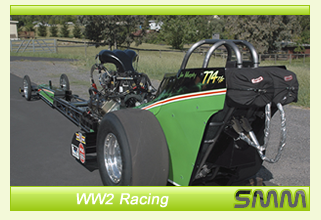 flag of hope once clutched by every car nut who had a dream of staging next to Don Garlits in the final round of Top Fuel at Indianapolis Raceway Park. flag of hope once clutched by every car nut who had a dream of staging next to Don Garlits in the final round of Top Fuel at Indianapolis Raceway Park.
The desire to recapture the feeling and the excitement of what was once commonplace was left to a few stalwarts who refused to lose an opportunity to once again experience a time and a tradition that is glaringly absent in drag racing today. It was an uphill battle of sorts until they were recognized as “innovators” in the present tense. Funny how everything that’s old seems new again.
Jim Murphy and the WW2 Racing Team (www.ww2racing.com) from Santa Rosa, California, have been making a name for themselves in the NHRA Heritage Hot Rod Series for several years with their front engined top fuel dragster and it’s clear that they are serious title contenders in 2009, not merely content to make appearances for exhibition runs that whet the appetites of those who follow the nostalgia drag racing circuit. Murphy and his team of twelve have collaborated and applied their collective knowledge and years of experience into a world class operation that demonstrates their ability to be competitive without the assistance of mega-corporate sponsors. Their success has been based upon the same tenets the early racers relied upon — hard work, creativity and dedication, a combination of attributes that are as relevant today as they were fifty years ago.
Although it appears to be a relic from the past, the new WW2 dragster is a far cry from the simplistic machines that dominated the top fuel ranks in the 1960’s. Beneath the surface lurks a composite of the latest technology that enables them to attain speeds and times never thought possible even a few years ago. These components were put to good use when WW2 made it to the semifinals this year at the March Meet in Bakersfield, California.
Performance is one thing but appearance is another and WW2 is long on style thanks to Kurt Strouse, the owner of KS Kustom Signs and Auto Graphics (www.kskustomsigns.com) in Santa Rosa, California. Kurt’s ability to capture the unusual is evidenced in his paintwork artistry that enhances a primarily green and black paint scheme with an intricate overlaid flame design that begins at the front and continues the length of the dragster, giving the illusion that there is movement even though the car is standing still.
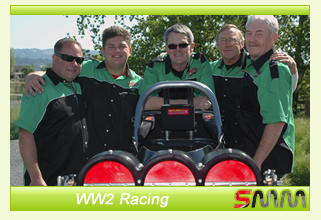
The credit for success is predicated upon a collective team effort and Jim Murphy,the owner and driver of WW2, will be the first to place credit where it is due. Without his team, any aspiration of winning remains just that, a dream, a visage that quickly vanishes at the first light of day. Crew pictured here: Mark Keiser, Shawn Keiser, Jim Murphy, Russ Denner and Daniel Wilkison; crew not pictured:Tim Beebe, Ron Rapadas , Dave Thornhill, Ray Littlefair, Michael Beebe, Jeff Baranek, Mike Cmelik, and Cheryl Grisel.
Speedway Motorsports Magazine had the opportunity to spend some time in the WW2 “skunk works”, coming away very impressed with the team’s meticulous attention to detail and a greater appreciation for the hard work and preparation that goes into top fuel cars today. Much of the history surrounding Jim’s extensive drag racing career can be found at his WW2 website but several questions still lingered.
SMM: Jim, your first involvement in drag racing dates back to a time when it was possible for an average guy with little or no sponsorship to put together a car that would be competitive not just locally but nationally. Today that's not the case. Has the sport gone too corporate?
JM: Well, John, I guess I h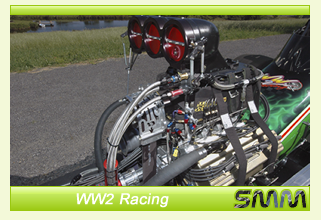 ave to answer that for me personally, the answer would be yes. I think that for many drag racing fans across the country and the people making a living at it today would probably say "maybe"! What has happened I think is that corporate America has certainly gotten involved in something that I took as my hobby or just a lot of fun, something you could do and make a few dollars with, and the comraderie of the guys and the other team members and other teams, was something very special that has gone from today's NHRA drag racing. Today the crew members are kept within their own little areas and they don't want to share secrets or things they've found out with competitors and you can't really blame them because it's serious business. There's a lot of money involved and a lot of pressure from the different corporations that sponsor the different drivers and teams. I'm sure they're enjoying it but I know it's a lot of hard work. I don't go to the NHRA drag races too often, maybe once a year, and I don't see the smiles out there that I once saw. ave to answer that for me personally, the answer would be yes. I think that for many drag racing fans across the country and the people making a living at it today would probably say "maybe"! What has happened I think is that corporate America has certainly gotten involved in something that I took as my hobby or just a lot of fun, something you could do and make a few dollars with, and the comraderie of the guys and the other team members and other teams, was something very special that has gone from today's NHRA drag racing. Today the crew members are kept within their own little areas and they don't want to share secrets or things they've found out with competitors and you can't really blame them because it's serious business. There's a lot of money involved and a lot of pressure from the different corporations that sponsor the different drivers and teams. I'm sure they're enjoying it but I know it's a lot of hard work. I don't go to the NHRA drag races too often, maybe once a year, and I don't see the smiles out there that I once saw.
SMM: Has there ever been a time in your drag racing career when you felt the risks involved in top fuel racing far outweighed your desire to continue?
JM: Not for me. I came out of boat racing where I raced blown fuel flat bottoms and I'd have to say the risk there is far greater. The dragsters and the funny cars that I've raced over the years, I feel very safe in them. You're really encapsulated within a chrome alloy tube that's built quite solidly. When I think about when the safety equipment wasn't as good as it is today, that was a time when I wasn't near as smart as I probably am today so I didn't even think about it! So, I have not had those kinds of concerns during my racing career.
SMM: I'm sure you're aware there are many people who feel that green is an unlucky color, especially in a race car. With this in mind, what made you decide to paint your car green?
JM: I can't even believe you'd ask me that question, John. I'm Irish! And also, it's the color of money! I guess it came from when Tim Beebe and I raced together for the first time in a top fuel dragster called Beebe and Murphy and it was painted with the green stripes similar to Tim's earlier car which was Beebe and Mulligan. I just really like green and I think probably the main reason is that because so many cars are red and black, I've always tried to get something that when I come around into the bleach-box, I want it to stand out so people know what car it is. So I've had yellow cars and green cars primarily and they seem to stand out a lot more.
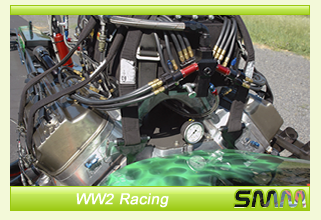
SMM: So your new dragster carried you to the semis at this year's March meet in Bakersfield after qualifying third overall. It's still early in the season yet but has the car lived up to your initial expectations?
JM: Oh yeah. We're really tickled with this car and I think it's going to run very well. We were not even able to make a full run at Bakersfield and still ran just about as well as anyone. So, I am very pleased with it. It has certainly lived up to expectations. We probably need another race or two to really get every little thing sorted out but as I mentioned earlier, I wasn't able to make full runs at Bakersfield. Eleven hundred feet is as far as we went because we had some problems with where the windshield was. I sit a little higher in this car and the wind was buffeting my helmet and trying to rip it off my head so I wasn't able to see. Once I got to about eleven hundred feet, it was up over my eyes so I had to shut off. It's really tough to hang on when you can't see down at that end!
SMM: Do you see the participation and enthusiasm for the NHRA Hot Rod Heritage Series and other nostalgia racing venues increasing in the future?
JM: I think the littler races like the Heritage Series, which is certainly a step down from the NHRA's big show, do seem to be gaining popularity, especially the funny car areas coming back which is really pretty neat. Of course I have a soft spot in my heart for the funny cars and probably if I wasn't in the winter of my career in fuel dragsters, I might think about switching but I'm pretty happy with where I'm at. The turnout at Baker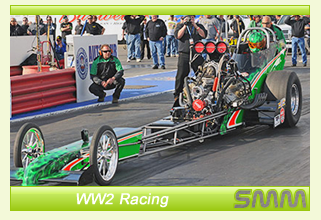 sfield, which was the first race for '09, was just a barnburner. I mean the place was packed — record cars, record crowds, everything. I'd have to say I think interest is increasing.The economy is certainly taking its toll on everything including all forms of motorsports but at Bakersfield, you wouldn't have known there was a recession there at that race. Everything was great. We haven't had the second Heritage Series race yet. It will be coming up and I expect it will do pretty well also. sfield, which was the first race for '09, was just a barnburner. I mean the place was packed — record cars, record crowds, everything. I'd have to say I think interest is increasing.The economy is certainly taking its toll on everything including all forms of motorsports but at Bakersfield, you wouldn't have known there was a recession there at that race. Everything was great. We haven't had the second Heritage Series race yet. It will be coming up and I expect it will do pretty well also.
SMM: There have been a lot of things written about drag races over the years. When all is said and done, what would you like to have written about you?
JM: That's a good question! I guess I'd like to read that Jim was a guy who raced fair, didn't mess around with people, did what he said he was going to do, and was a fair guy and a good friend. That's what it's all about.
|





